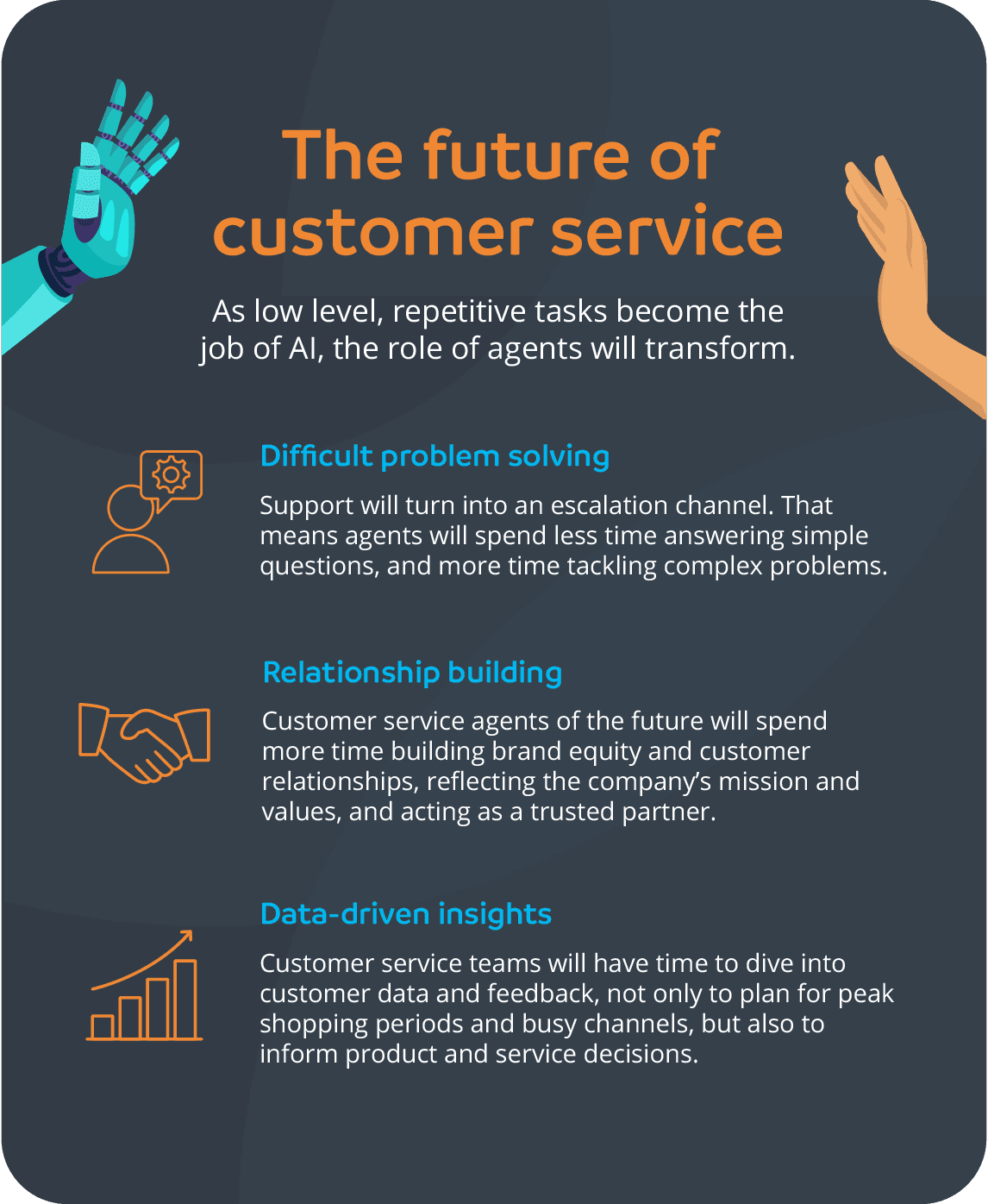5 ways AI is changing customer service
Jumbo may not be familiar to many globally, but, mention the supermarket chain in the Netherlands and there will be instant recognition. One hundred years of history. A 21.5% market share. About 100,000 employees across 700 stores1. More than a century after it started life as a grocery wholesaler2, Jumbo is every bit a retail juggernaut and much of its modern-day success is due to a growing commitment to intelligence-driven customer service.

“To turn even more of our customers into fans, we need to offer them a more personalized and responsive experience,” explains Jumbo’s Wendell Kuling. “But to do this, we needed to move from analogue processes to automation, infusing AI into our current processes to get insights faster.”
From its ‘Remind Me’ service that provides customers with an online list of products they may have forgotten to a loyalty program that delivers rich data insights3, Jumbo is a prime example of how organizations large and small are harnessing the power of AI to change the way they do customer service. It is no surprise that studies show 79% of customer service professionals believe AI and automation tools are important to their overall strategies4.
For those businesses yet to fully embrace such ground-breaking technologies or still debating its potential impact, here are five ways that AI is impacting customer service and further proof that its use leads to more productive organizations, substantial cost benefits and deeper relationships with consumers.

Source: How AI is Shaping the Future of Customer Service | Infographic (kustomer.com)
How AI is changing customer service
- Increased self-service: a funny thing has happened during the past few years. Where many people initially bemoaned being deflected to self-service options when reaching out to businesses, there is overwhelming evidence that today’s customers prefer finding answers to their questions. One study shows 67% of consumers would rather use self-service than speak to a company representative5, while 91% of customers would use an online knowledge base if it was tailored to their needs6. The good news is AI and machine learning are enhancing the speed, accuracy and usability of self-service tools and platforms in ways businesses could once only have dreamed of.
- Round-the-clock support: one of the greatest pressures for businesses in 2023 is meeting the expectations of customers who want service on their terms. No matter where they are or the time of day (or night), an increasing number of people believe they should be able to pick up their phones or log on to their computers and receive immediate assistance with their inquiry. Fortunately, automation is helping deliver such 24/7 support across all channels, be it via chatbots, virtual agents or FAQs and knowledge bases. AI can even monitor social media platforms to detect potential concerns or negative commentary before they become major issues.
- Personalization: a generation ago, personalized service was all about remembering a regular customer’s name at the check-out. Today AI has created an environment where businesses can offer a level of personalization that defies belief. Software-based platforms can collect user data, classify it and then reuse it to enhance engagement between products and consumers and, in turn, increase customer loyalty. One of the best examples is Netflix, which has shattered traditional entertainment models by collecting users’ search histories, analyzing their data and providing a swathe of personalized and incredibly accurate viewing recommendations.
- Improved agent focus: one of the key benefits of AI-powered chatbots taking on more repetitive and time-consuming customer interactions is that human agents are able to dedicate more time to dealing with and solving complex issues. While automation takes care of simple services such as bill payments and questions about opening hours, humans can increasingly take care of inquiries that require nuanced communication skills and engagement. By relieving agents of mundane and heavy workload tasks, the technology is creating a more rewarding and stimulating environment for staff and providing customers with more reasons to be satisfied with the care they receive.
- Sentiment analysis: they say the pen is mightier than the sword and that is certainly the case when it comes to customer sentiment. There is no doubt that negative feedback or reviews travel further and faster than positive ones, which is why it is crucial that organizations do their best to stay across what is being said about them. This is particularly so in the digital age and AI is playing a key role in the field of sentiment analysis, which sees the technology used to analyze comments posted on social media, review sites and online surveys to spot negative attitudes and trends towards their products or services. Armed with such knowledge, customer experience leaders and their teams can then work to address those issues in real-time and make positive changes for the future.
.png?width=707&height=406&name=What%20do%20you%20like%20about%20AI%20in%20customer%20service-_desktop%20(1).png)
Source: The State of AI in Customer Service Report 2022 | Dialpad
Summary
The past year has seen the spotlight fall on artificial intelligence like never before and while there has been plenty of focus on potential risks, they are surely outweighed by the benefits when it comes to customer service. AI is allowing businesses to improve efficiencies, reduce costs and better engage with customers but that does not just happen. With endless solutions on the market, it is essential to identify the tools and platforms that suits one’s needs and create AI strategies that deliver the best results for individual organizations.
Negative call center interactions may not only result in poor experiences for customers but brand damage for the organizations they have called. Discover how a quality call center script can help agents to navigate all manner of conversations, including examples of the solution in action.
Reference:
[1] Microsoft Customer Story-Jumbo turns customers into fans using automation and AI
[2] Jumbo (supermarket) - Wikipedia
[3] How Jumbo Transformed the Grocery Shopping Experience With Data and AI - The Databricks Blog
[4] The State of AI in Customer Service [New Data] (hubspot.com)
[5] https://www.zendesk.com/resources/searching-for-self-service/
[6] 32 Customer Experience Statistics You Need to Know for 2024 (superoffice.com)
Popular posts
Browse by topic
- Accounting
- Accounting & Finance
- All Industries
- Banking
- BPO/RPO/HRO
- Communication
- CSR & ESG
- Customer & Client Acquisition
- Customer Experience
- Cybersecurity
- Cybersecurity & Compliance
- Data Management
- Digital Operations
- Digital Transformation
- eCommerce
- Education
- Employee Engagement
- Engineering & Construction
- Financial Services
- Healthcare
- Hospitality and tourism
- HR & Recruitment
- Information Technology
- Insurance
- Legal Services
- Logistics
- Offshoring & Outsourcing
- Outsourcing
- Professional Services
- Real Estate
- Retail & eCommerce
- Startups
- Talent Acquisition and Retention
- Technology
- Trends & Guides
- Workforce Integration
Sign up for the offshoring eCourse
12 in-depth and educational modules delivered via email – for free
Related Posts
Is offshore staffing the key to data compliance?
With entire websites dedicated to exposing businesses daily that have been hacked or have had their data breached daily, it’s no wonder why data..
The ultimate guide to outsourcing data processing services
For more than a century, Harvard Business Review has been a go-to resource for managers wanting insights into topics such as leadership, negotiation,..
How to outsource health information management (HIM)
What is outsourced health information management (HIM)?
